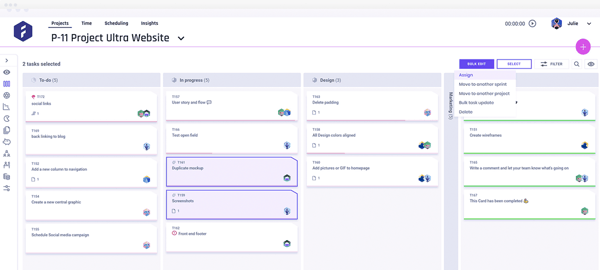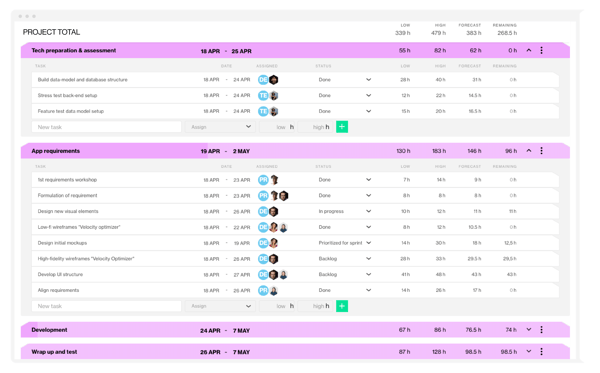9 Steps to Plan Your Way Out of Scope Creep

Scope creep is a threat to any project. Understanding your client's vision is key to a successful deliverable. Likewise, setting a clearly defined scope for the project is paramount to deliver on-time, on budget, and with the right solution.
Summary of key findings
- Understanding your client's vision is the first step to deliver a successful project. Make sure you understand the problem that is to be solved and for whom.
- Set the project requirements together with your client. This is done based on the previously defined problem.
- Defining inside and outside of scope. The project requirements are converted to milestones and an estimated time frame, capacity, and budget is set up.
- Ensure your client understands the process of moving outside of scope, and why. Moving outside of scope will affect your capacity, the price of the project, and previously defined deadlines.
- Defining tasks and limitations to the scope. With an accept from your client, milestones are now scoped out into more granular tasks. A more specific time frame, capacity report, and price can be estimated during this process.
- Use a collaborative project management platform that connects your scoping process with scheduling, and your budget with tasks and time registrations. Finally, use a platform that connects with your other tools and deliver instant insight reports.
- Invite your clients onto the project management platform with limited access. This allows you to communicate the progress better.
- Accepting new requests from the client can be an opportunity of up- or cross-selling. However, this needs to take place in a controlled environment.
- Implementing new requests with a proposal is easier when you manage the project in a controlled environment, a project management platform. Add an extra milestone to your scope and create a new proposal.
Scope creep happens when new tasks sneak up on you without being part of the Statement of Work (SOW). Often it hits you with a sneak attack, and before you know of it, your project is off-track and off-budget. Setting your profitability at risk - not only of this project, but also by limiting the capacity available for others. Following are 9 steps to avoid scope creep.
1. Understand your client's vision
First things first, the best way to understand your client is to talk with your client. Sit down together, brainstorm the idea, and spend some time listening to your client's vision, your vision for the project, and combine the two.

Managing a project is a collaborative effort. This effort includes both your internal- and your external stakeholders and not to mention, your client. Inviting your client along for the ride ensures a better mutual understanding and a deliverable in-sync with the initial vision.
Key takeaway: Mutual understanding is key in any relationship. Understanding the vision and sharing information between stakeholders ensures a successful deliverable.
2. Set the project requirements
Following the mutual understanding, you can move forward with the definition of the project requirements. Setting the requirements are based on the vision of the project. What is the problem that we're trying to solve and who is the target of the deliverable in the end.

What is the deliverable? What problem does the project address for the product? What needs to be solved? How should the product resolve the problem? Who is going to use the product, and how? What would be the best possible experience for the end user? What would be the simplest solution? What would be the most advanced solution? What is the aim of the product? Answer each question, and save it for later.
Key takeaway: Setting the project requirements sets the foundation for the final deliverable. What do we need to deliver?
3. Define what's inside and outside of scope
Definition of the scope is based on the vision and the requirements as specified earlier. What is inside, and what is outside of this project's scope? Scope out the milestones inside the scope, and make sure both your client and your project team understand these boundaries.

Remember that any extra requirements, adaptions, add-ons, etc. can always be added later through a second project. Common is also to add new requests to a new milestone that can be accepted upon through an extension to the initial Statement of Work (SOW). All things considered, defining every aspect of the scope will set your project up for success and will help to avoid scope creep.
Key takeaway: Having a shared view of what is inside and what is outside of scope is key to avoiding scope creep. Any additional work can be added as a signed extension to the SOW.
4. Explain the process of moving outside of scope
Often new requests do come along the way. In this case, make sure to explain to your client the process of adding new tasks to the project. Your defined limitations from earlier should always be kept in mind. Moreover, a critical eye should be kept on the project timeline, your schedule, and available capacity of resources. People that could potentially already be allocated to other projects in your organization.

Key takeaway: Ensure that the capacity of resources is available when accepting extra work. Key resources may already have been allocated to other projects.
5. Define tasks and limitations
Setting up the actual Statement of Work (SOW) is done with the previously defined boundaries in mind. The SOW should clearly (always clearly) define the milestones and tasks of the project. This is especially important when managing a larger team that might not know all the pieces of the puzzle. Make sure to clearly define the task, and how the deliverable should be used by the end user (like a User Story).
Additionally, if needed, define any limitations that may be to the scope of the project. Scope creep does not necessarily come from outside. It may as well stem from the goodwill of your team members. Your team members hopefully want to deliver their best, but sometimes that might be reaching too far out of scope. Ultimately, putting profitability and the time frame at risk.
Key takeaway: Clearly defining tasks and limitations of the current scope is crucial for a healthy project. Ensure your team and the client are on the same page.
6. Use a collaborative business management platform
Great projects need great management tools. Great teams need great collaborative tools. Simple as that. Sadly, many tools are neither great nor very collaborative in nature. Some tools are very complicated to use, and not at all a fun and inspiring environment to enter.

Other tools are quite good. However, may lack key functionality because they only focus on one part of a project. For example, the task management part (i.e., Trello), the time and budget part (i.e., Harvest), or the scheduling part (i.e., 10,000ft). A business management platform combines all of these features into one solution. This is the mission of Forecast.
Key takeaway: Managing great projects and great people need a great platform. Business management platforms combine features to give you a better understanding.
7. Invite your client to collaborate
A higher level of transparency and collaboration between client and agency can be ensured by inviting your client into your project management. Platforms like Forecast allows you to limit access to information on a role basis. For instance, a client will only see tasks that are relevant to them. Building and sharing progress reports are equally straightforward with a simple password-protected link.
95d8.png)
Key takeaway: Inviting your client onto your project increases transparency and collaboration. Platforms like Forecast can limit access to what is shared.
8. Approve or disapprove new requests
Dealing effectively with scope creep, you need to have a good sense of the scope. Likewise, you should be able to respond confidently with either a yes or a no when new requirements are requested. Forecast lets you manage this process inside of your project.

Forecast has this built-in by only showing milestones with a set start and end date on your timeline. That means any milestone which does not have a set time frame is still considered a draft and left out of the project work. This minimizes the risk of a team member initiating a task which is not yet agreed upon between client and agency.
Key takeaway: Knowing what you have agreed upon between you and the client is key to avoiding scope creep. Any extra can be added to a separate milestone or project.
9. Make a qualified proposal for new requests
Creating an extension to your initial proposal is a great way to manage new requests. Making new proposals is as easy as adding new milestones. Rates, capacity, and estimated time is taken into account to estimate extra costs, i.e. the price, and an estimated time frame.

This is a great opportunity for up- and cross-selling based on new requests from your client. If the proposal is accepted, you can quickly move the tasks along by adding the start and end date of the milestone. The new addition will now be visible in the project timeline and for the team members to work on.
Key takeaway: New requests are a great opportunity for up- and cross-selling. However, additions should be managed separately to ensure profitability and resource capacity.
Final takeaway
Avoiding scope creep is about balancing time, quality, and money. It's about ensuring that these three aspects are covered best possible. To do this, you need to plan accordingly. A business management platform can be a great help to manage this balance.
The most important factor to avoid extra work from piling up is to understand your client. Right from the first meeting, make sure you understand the needs of your client. Ensure you have the same view of the world, the scope, the vision, and the project altogether. All stakeholders, your team and your client, needs to be on the same page initially and as the project progresses.
Following the nine steps above should significantly improve your stakes of dealing with scope creep. Whether you're eagerly taking on extra work with new milestones. Or, instead prefer moving further requirements and requests to a separate project, these steps can hopefully help you out.
Other articles related to this subject:
You might like to read these articles on our blog..
Subscribe to the Forecast Newsletter
Get a monthly roundup of productivity tips & hacks delivered straight to your inbox

